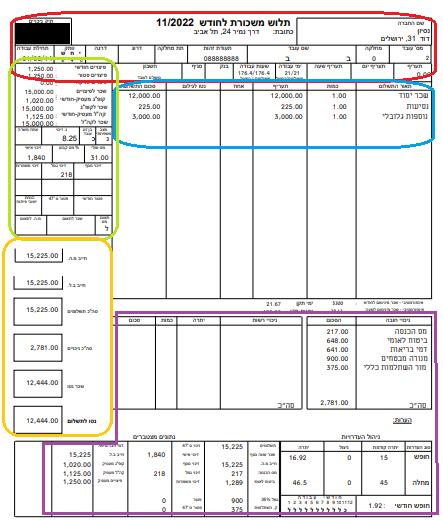If you are an employee, you receive a payslip from your employer each month showing you what you were paid and what was deducted.
For a lot of people this can appear like complete gibberish. Understanding what is written on your tlush (pay stub) is very important so you can make sure you are getting all your rights, all of the terms spelled out in your contract, and your nekudot zikui (tax credits). There is lots more to it than just the bottom line showing your net.
While they all need to have the same basic information, they don’t all look the same. The government wants to pass a law saying that all pay stubs need to follow a standard format, so that no matter where you work you would know how to read it. That said, don’t rely on the government to pass something like this as it is not on top of their to-do list.
Now without further ado, let’s jump into what a tlush looks like and how to read it. Take a look at this one. (It’s a fake one that I created for this post.) It belongs to a married man with three kids under 18 (ages 2, 4, and 10).

Red section:
Here you will see basic information about your employer and yourself, including your name, ID number, when you started working at your current place, how much you make per day and per hour, how many hours you worked, and your bank information.
Blue section:
You will see your salary as stated in your contract and any increase in salary you got, including overtime and travel costs. Sometimes when work gives you a gift or holds an event you will see something called שווי. Some employers cover the taxes on it so it shouldn’t affect your take home. This would show up as גילום.
Green section:
Here you can see how much of your salary is being deposited into your pension. If your salary is split between regular hours and global overtime (as shown above), make sure that both sections are being reflected in your pension deposits.
Underneath that you will see how many tax credit points you have. Men start with 2.25 and women start with 2.75. If you have kids, finished a degree recently, are a new oleh, or recently finished the army you are entitled to more. Each point is worth 223 shekel per point as of writing this post. This amount is deducted from the total income tax that you pay.
Orange section:
Your gross income minus deductions equals your net (aka what you see in your bank account).
Purple section:
This shows how much taxes you are paying and how much was deducted and put into your pension and keren hishtalmut. (Remember, if you donate over 190 shekels a year, you might be entitled to a tax return.)
Underneath that you can see how many sick days and vacation days you have accrued.
To the left of that, you will see the cumulative amounts that were deducted from your salary from the start of the year and how much was deposited into to your pension and keren hishtalmut if you have one.
Keep your payslips as they can help you. If you receive them by email, save them in a folder. If you get them in print, scan them and save it in an organized place. When opening a new bank account, you will need to provide your last 3 pay stubs.
Your employer must pay you by the 9th of each month. If you are not paid by then your employer can be breaking the law.
Do you have any questions about your tlush that we did not address? Leave your question in the comments and we will do our best to reply.
Subscribe to our blog

Leave a comment